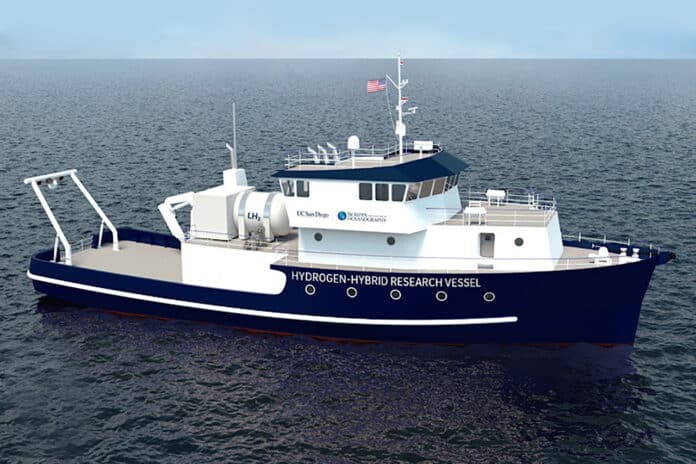UC San Diego’s Scripps Institution of Oceanography has selected the naval architecture and marine engineering company Glosten as the naval architect for the university’s groundbreaking new coastal research vessel. The new vessel will be an innovation in the maritime industry with a one-of-a-kind hydrogen-hybrid propulsion system.
For this project, Glosten will provide the preliminary design, contract design, and detailed design for the research vessel to be operated by Scripps Oceanography. The new research vessel will feature a hybrid propulsion system that integrates hydrogen fuel cells alongside a conventional diesel-electric power plant, enabling zero-emission operations.
The design is scaled so the ship will be able to operate 75% of its missions entirely using a non-fossil fuel – hydrogen – with only pure water and electricity as reaction products. For longer missions, extra power will be provided by clean-running modern diesel generators.
The proposed 125-foot (38-meter) long vessel will be equipped with a wide range of sensors, including acoustic Doppler current profilers, seafloor mapping systems, midwater fishery imaging systems, biological and geological sampling systems, and support for airborne drone operations. These capabilities will enable multidisciplinary research, advancing our understanding of the physical and biological processes active in California’s coastal oceans.
Last year, California legislators allocated $35 million towards the design and construction of this vessel that will serve as a platform for education and research dedicated to understanding the California coast and climate change impacts on the coastal ecosystem.
The development of this and subsequent zero-emission vessels is essential to the University of California’s Carbon Neutrality Initiative, the goal to be carbon neutral by 2025. This new vessel will be dedicated to California research missions, with the capability to study issues vital to the California economy, such as the health of marine fisheries, harmful algal blooms, severe El Niño storms, atmospheric rivers, sea-level rise, ocean acidification, and oxygen depletion zones.
The anticipated schedule for design and construction includes one year to complete the basic design. Following U.S. Coast Guard approval of the design, the university will select the shipyard where the design will be constructed. Construction and detail design will likely take an additional three years.
When completed, it will join the fleet of vessels managed by Scripps, including the Navy-owned research vessels Sally Ride and Roger Revelle, which conduct global oceanographic research, and the R/V Bob and Betty Beyster, a nearshore scientific workboat. All research vessels are stationed and maintained at the university’s Nimitz Marine Facility in Point Loma. The new vessel will replace research vessel (R/V) Robert Gordon Sproul, which has served thousands of University of California students in its 42 years of service but is nearing the completion of its service life.
